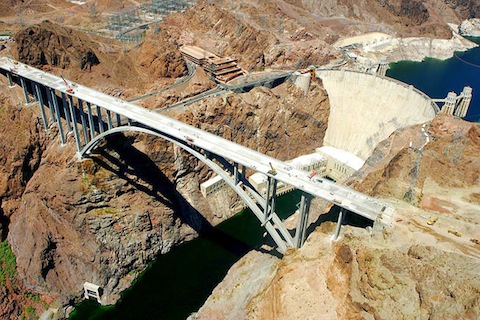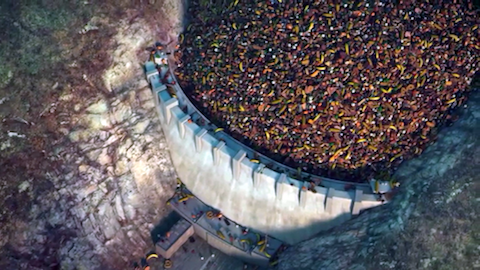Hoover Dam, arch bridges, and meatballs
October 29, 2010 at 9:17 PM by Dr. Drang
Since today’s blog theme seems to be concrete, I thought I’d mention that the Mike O’Callaghan–Pat Tillman Bridge—also known as the Hoover Dam Bypass Bridge—officially opened just over a week ago. It’s a wonderful concrete arch bridge that spans the Colorado River canyon just downstream of the dam.
Our family’s spring vacation this year ended in Las Vegas and we went out to the dam for the tour. Here’s what the bridge looked like then, as seen from the dam.
Structurally, an arch bridge is the perfect form to span a rocky canyon. In addition to the downward force from their weight, arches also produce an outward thrust at each base. The solid rock walls of a canyon are the ideal foundation to carry that thrust.
The material is right, too. Although you can certainly make arches from steel, masonry and concrete are the traditional arch material.1 Stone, brick, mortar, and concrete are all weak in tension but strong in compression; the geometry of the arch, curved into the load acting on it, ensures that the stresses in it are substantially—if not entirely—compressive.
Most important, though, is that the concrete arch of the bridge matches the form and material of the dam.

Hoover Dam is a horizontal concrete arch, curved into the pressure from the water behind it. The two work together very nicely.2
And speaking of arch dams, I’m going to use this post to tie up a blog thread that’s been hanging loose for almost a year. Last November I wrote a post about Cloudy With a Chance of Meatballs, a movie I’d just seen with my sons. I liked it a lot, but there was one part that really bothered me: the dam that figures in the climax of the movie.
The dam is built to hold back the excess food. Much more food falls from the sky than can be eaten, so Flint [the hero] makes a machine that scoops up the leftovers and flings them across the island into a sort of garbage reservoir retained by a dam. The dam seems to be modeled on Hoover Dam, with a nice horizontal arch…
And that’s what horrified me about the dam in Meatballs: it’s curved the wrong way! Being curved away from the load puts the dam entirely in tension. No wonder it—spoiler alert!—bursts and floods the town with leftovers during the climax. It should never have lasted as long as it did.
To my regret, I couldn’t find a image of the dam in Meatballs, so the post was written with just a description. This summer, though, friend of the blog (and toast of Honolulu) Matthew McVickar was watching the movie via Netflix, remembered my complaint, and took a screen capture of the dam to send me. I’ve been waiting months for an opportunity to use it.

The multicolored stuff above and to the right of the dam—on the wrong side of the curve!—is all the leftover food the dam is supposed to be holding back. If only Flint had consulted me first…
-
As opposed to the traditional arch enemy. One of my favorite parts of last week’s premiere episode of the new Sherlock Holmes series on PBS was Watson’s question “Do people have have arch enemies?” ↩
-
By the way, look how low Lake Mead is. The white areas on the reservoir walls show how high the water has been in the past. You can also see how much of the intake structures—the things that look like towers just upstream of the dam—are exposed because of the low water. ↩

